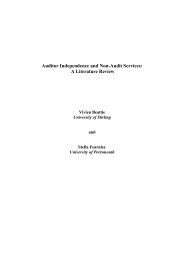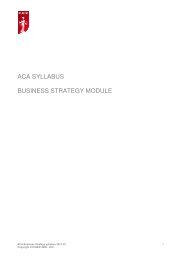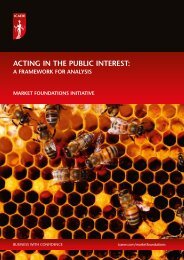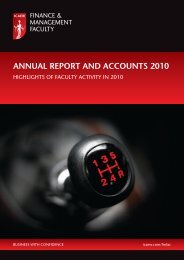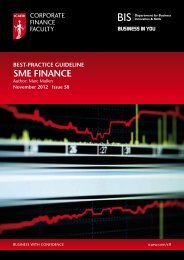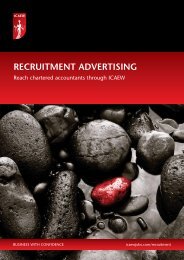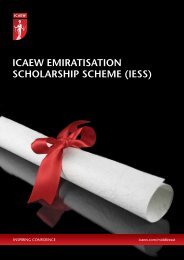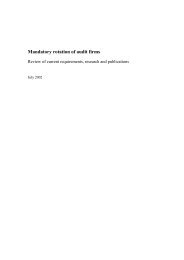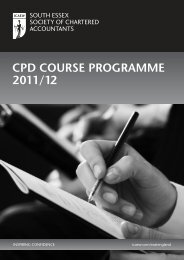3. STRUCTURING ASSURANCE ENGAGEMENTS - ICAEW
3. STRUCTURING ASSURANCE ENGAGEMENTS - ICAEW
3. STRUCTURING ASSURANCE ENGAGEMENTS - ICAEW
- No tags were found...
You also want an ePaper? Increase the reach of your titles
YUMPU automatically turns print PDFs into web optimized ePapers that Google loves.
<strong>3.</strong> <strong>STRUCTURING</strong> <strong>ASSURANCE</strong><strong>ENGAGEMENTS</strong>How do standards and guidance help professional accountantsprovide assurance? What are the practical considerations whenstructuring an assurance engagement?
<strong>3.</strong> <strong>STRUCTURING</strong> <strong>ASSURANCE</strong> <strong>ENGAGEMENTS</strong><strong>3.</strong>1 IntroductionThe primary users of this section, which outlines key considerations in developing the structureof an assurance engagement, and section 4, which addresses the delivery of assuranceengagements, are those practitioners who carry out assurance engagements and those whoinstruct the practitioners to carry out the service. Familiarity with the breadth of potentialassurance engagements and the key components of the assurance framework enables thepractitioner to work with their client and the other stakeholders to design an assuranceengagement that meets users’ needs.Assurance reporting may be requested in relation to the operations of a different party, forexample an outsourced service provider. In this situation the client is normally the user, withthe responsible party as the outsourced service provider. More details on the three-partyrelationship are given in <strong>3.</strong>4.<strong>3.</strong>2 Scope and positioningThe IAASB’s Framework defines and describes the elements and objectives of assuranceengagements. More detailed engagement standards set out basic principles, essentialprocedures and related guidance, and support the application of the Framework in practice.The elements of assurance in the Framework are required to be present in any assuranceengagement. Consideration of those elements assists practitioners to structure an assuranceengagement with their clients where no standard or guidance on the specific subject matterexists. An overview of the elements of assurance engagements was provided in 2.4.1:• a three-party relationship;• an appropriate subject matter;• suitable criteria;• sufficient appropriate evidence; and• a written assurance report.These concepts are considered further in this section.Discussion with clients when scoping an assurance engagement is an important process.It should help the practitioner to obtain a sound understanding of the objective of theengagement, the nature of the subject matter, and the requirements of both the client andusers. This understanding helps the practitioner plan procedures to gather sufficient andappropriate evidence to come to a conclusion that is useful in the light of the users’ need.The practitioner should note that it is possible to obtain assurance on almost any subject matter(or subject matter information) provided that the scope of the assurance engagement is in linewith the relevant standards eg, the method of measuring or evaluating the subject matter isappropriate, criteria are suitable, and sufficient and appropriate evidence exist. However, anassurance engagement may not always represent the optimal approach from a cost benefitperspective. Other approaches, such as AUP, may achieve the required outcome with lesseffort on the part of both management and the practitioner.To commence an assurance engagement, the practitioner will need to outline engagementstandards with the client. International engagement standards issued by the IAASB include:• ISAs (International Standards on Auditing) or ISREs (International Standards on ReviewEngagements) – on historical financial information.• ISAEs (International Standards on Assurance Engagements) – on any subject matter otherthan historical financial information.In addition, the IAASB issues International Standards on Related Services covering nonassurance services such as AUP and compilation engagements.24Structuring assurance engagements
ISAE 3000, Assurance engagements other than audits or reviews of historical financial informationapplies to subject matters that are not covered by subject-specific engagement standards.Subject matter specific assurance standards include ISAE 3402 relating to financial internalcontrols of service organisations and ISAE 3410 relating to greenhouse gas emission statements.Table 2: Existing standards and guidance for various subject matter areasAssurance area/subject matter areaQuantitative information, including financialinformation and performance measures suchas KPIsAspects of information technology such asinformation flows and securityAssurance standard(s)/guidanceISAs, ISRE 2400, ISRE 2410, ISAE 3000,ISAE 3420, SIR 4000, AAF 02/06, AAF 03/06ISAE 3000, ITF 01/07Management information flows ISAE 3000Regulatory processes and compliance ISAE 3000Compliance with contractual agreements ISAE 3000Operations and projects, includingoutsourced operationsGovernance, strategy and managementprocessesISAE 3000, SSAE 16, ISAE 3402, AAF 01/06ISAE 3000, AAF 01/06 StewardshipSupplementEnvironmental information ISAE 3000, ISAE 3410The internal controls and internal controlenvironmentISAE 3000, ISAE 3402, AAF 01/06Risk management systems and processes ISAE 3000Ethics and behaviour ISAE 3000Financial processes ISAE 3000, APB Bulletin 2011/2Greenhouse gas emission statements ISAE 3410Details on standards and guidance referenced above are provided in Appendix 2. The table inAppendix 2 also provides ‘vignettes’ to illustrate the variety of services that may be provided.<strong>3.</strong>3 Business activities<strong>3.</strong><strong>3.</strong>1 ContextOwners and managers are engaged in activities to fulfil the objectives of the organisation.Management has a responsibility for the design and implementation of appropriate processes.The board of directors, or where applicable, the audit committee, or their equivalents suchas the board of trustees in non-corporate environments, has responsibility for the governanceof the organisation. Within this environment, assurance can play a key role in enhancingstakeholder confidence over operations within the scope of the engagement.<strong>3.</strong><strong>3.</strong>2 Management responsibility 3Management, who may also be owners, are responsible for running the business. Accordingly,they are responsible for the subject matter on which an assurance conclusion is sought. Beforeentering into an assurance engagement, owners and management need to be confident inpositively asserting that the business is meeting the relevant objectives, is compliant withrelevant contractual and other legal and regulatory obligations, operational and/or reportingprocesses are designed appropriately and operated effectively, and data is complete andaccurate. If management themselves are unsure of whether the subject matter is meeting itsobjectives or unable to support this assertion with evidence, there is little point in entering intoan assurance engagement.In an assurance engagement, it is usual for the responsible party, normally management,to measure the subject matter and report in the form of subject matter information on theoutcome of the measurement of the subject matter. Reporting of subject matter information3As explained in section 1, ‘Management’ may refer to senior management, executive management, the board of directors,or in certain cases, those charged with governance, depending on the context. Here the term is used to refer to those withresponsibility for the subject matter.Structuring assurance engagements25
y the responsible party is a prerequisite for such ‘attestation’ engagements. This is becausemanagement is accountable to the owners or those charged with governance for how theyrun the business or for aspects in which business partners are interested.In other cases ie, where management does not produces the information on the subject matter,the practitioner gives a conclusion directly on the subject. In either case, management isresponsible for the underlying assertions on the subject matter. If management is not producingthe subject matter information which incorporates its assertions, management assertions maybe issued in a stand-alone statement alongside the assurance report by the practitioner.<strong>3.</strong><strong>3.</strong>3 Four stages of management responsibilities 4Practitioners need to identify a series of basic concepts for how owners or managementtogether with those charged with governance operate and control the business or organisation.The concepts set out below may be more formalised and better documented within largerorganisations. Within small or medium sized businesses and other organisations these conceptsmay be established as an integral part of the intentions and actions of the owners andmanagers but may not be systematically documented.These four concepts are:1. Leading and establishing the tone at the top.2. Establishing strategy and aligning objectives.<strong>3.</strong> Implementing processes, policies and procedures.4. Utilising information flows to monitor the performance of the business or operations.The way that owners and management run the business affects the nature of the assuranceengagement, as different owners and management may have different ideas to what aspect oftheir business should be looked at by a practitioner, what should be used as criteria, to whomthe report should be addressed, and what evidence may be available. The degree of monitoringof management as evidenced through documentation also affects the nature and scope ofassurance engagement. The relationship between the four management concepts/activities andthe focus of different assurance engagements is summarised in the following figure.Figure 2: Assurance reporting on differenct aspects of management activitySubject matter aspectManagementactivityData andoutcomeOperatingeffectivenessDesign Fair description ComprehensivereportMonitoringthe processand controleffectivenessProcessand controlimplementationEstablishingstrategy andobjectives4 4 4 48 4 4 48 8 4 44Tone at the top 8 8 8 4For any level of management activity it is possible for an assurance engagement to focus on arange of subject matter aspects as indicated.Leadership and tone at the top of the organisation, or key elements of this, may best beapproached through the practitioner providing an opinion on the fairness of a description ofwhat the management has set out to do thus far. This is because, initially, the design suitabilityand the operating effectiveness of the arrangements may not withstand external scrutiny dueto the pervasive and wide ranging ramifications within the organisation.As strategy and relevant objectives are better developed, the arrangement may become sufficientlyformalised and enable assurance reporting over the design suitability of the arrangements in place.4Here, ‘management’ will normally refer to the executive management and / or the board of directors as appropriate.26Structuring assurance engagements
Process implementation and monitoring lends itself to assurance over operating effectiveness.An assurance engagement may then focus on either the operating effectiveness of theprocesses or the data and outcomes measured against criteria as part of monitoringby management. At this stage, the entire arrangement enables management to reportcomprehensively on its activities for the benefit of the intended users, which may be thesubject matter information for the assurance engagement.The different management activities and related focus of assurance engagements can beregarded as a progression such that more comprehensive assurance is provided as themanagement and governance of the entity increases in sophistication over time.From the practitioner’s point of view, the main factors affecting the practitioner’s approachto an assurance engagement will be further defined by a number of factors, in particular theneeds of the users:• Who will benefit from or use the information?• Why do they require assurance?• What is their underlying need?Answers to these questions and consideration of how the five elements of assurance engagements(<strong>3.</strong>2) apply in each engagement setting will help in structuring assurance engagements.CASE STUDIES: ScopePerformance metricsAssurance over operationalsystemsUK Stewardship Code complianceScopeThe company’s auditors wereapproached to discuss whatassurance they might be ableto provide to include in theirpublished report. The companywas able to provide:• Detailed analyses and evidenceshowing how the objectiveslinked to the metrics.• Explanations as to why certainmetrics had been chosen andothers not.• For each metric, what datahad been used, from withinthe company, drawn fromindependent bodies such asBARB, and obtained fromcontractors operating systems forthe company.The company, however, did nothave a documented version of themethodology.The audit partner suggested thatan assurance report could beprovided to existing customers overthe operation of the systems runby the company. This was basedaround:• The company agreeing with itscustomers a set of controlobjectives for the relevantsystems.• The company documenting thesystems in a way that enabledcontrols to be related back torelevant objectives in a structuredway.• The design of the systems to beevaluated and a report providedto the company to enable themto address any control weaknesses.This report would be sharedwith the existing customers andinclude the management actionsbeing taken by the company.The practitioner and the assetmanager discussed and agreed thatthe asset manager is ready to adoptminimum assurance reporting andfocus on a fair description of howthe principles of the Code havebeen applied.While there are seven principlesin the Code, only four of these,including its management ofconflicts of interest and votingactivities, are considered suitablefor objective evaluation. Thescope of assurance report is thusdetermined to focus on thesefour objectives.• A programme of testing designedto enable the practitioner toprovide a reasonable assuranceopinion over the design suitabilityof the controls of the companyfor a defined period that wouldbe copied to the customers.Structuring assurance engagements27
<strong>3.</strong>4 Three-party relationshipAssurance engagements envisaged in this guidance involve three parties: the responsible party,users, and the practitioner. The responsible party performs operations or provides informationfor the benefit of or relevant to users. It is responsible for the subject matter over whichassurance is sought. Users are typically the recipients of services, assets or information of theresponsible party, although in some cases the relationship between users and a responsibleparty may not merely be one-way.The practitioner is engaged to perform an assurance engagement in relation to the subjectmatter or the subject matter information that the responsible party is responsible for. Eitherthe responsible party or users, or in some circumstances both, may engage the practitioner asshown in <strong>3.</strong>4.4.<strong>3.</strong>4.1 The responsible partyThe responsible party is responsible for the subject matter and subject matter informationwhere produced. Where there are two organisations (such as an assurance engagementassigned by a service provider), the responsible party typically performs operations orprovides information for users in a manner usually governed by a written contract. However,the relationship between the responsible party and users is not always contractual orclearly defined.<strong>3.</strong>4.2 UsersUsers are the parties that are affected by the activities of the responsible party. In a businesscontext, users may be in a contractual relationship with the responsible party which performsspecific activities for their benefit. Where appropriate, users may also receive informationin relation to the operations of the responsible party. The type of the operation performedor information provided by the responsible party, the number of users, how they want theinformation reported and the criteria used will vary. An assurance engagement may beperformed in relation to all users or may be restricted to specific users. Where an assurancereport is intended for specific users, the assurance report clearly indicates that fact.In some cases, there may be users that are unidentified at the start of the engagement. Thismay happen where, for example, the responsible party intends to publish the assurance reporton its website. Where this is the case, the risk of the assurance report being received by thosewho are not party to the engagement, and therefore do not fully appreciate the purpose of thereport, may increase. The practitioner’s duty of care therefore needs be clearly reflected in theengagement letter, in the assurance report and throughout the conduct of the engagement.See AAF 04/06 for further guidance.<strong>3.</strong>4.3 The practitionerThe practitioner agrees with the engaging party the scope of the engagement, the reportingrequirements and ensures that there is appropriate access to the personnel and informationof the responsible party and, if applicable, external parties including the users.The practitioner’s responsibilities will vary depending on who the engaging party is andtheir needs. To a degree, those responsibilities and needs will be driven by whether theengaging party is the responsible party, the users or both. The practitioner considers whetherthe responsibilities have been defined to an appropriate level, including the nature of thedeliverables, when accepting an engagement.In an assurance engagement, the practitioner is responsible for determining the nature, timingand extent of procedures so as to gather sufficient and appropriate evidence. He also pursues,to the extent possible, any matter of which he becomes aware and which leads him to questionwhether a material modification should be made by the responsible party to the subject matterinformation or to their assertions and to consider the effect on the assurance report if nomodification is made.<strong>3.</strong>4.4 Parties involved in an assurance engagementThe form of engagements may differ depending on who is involved in the assurance process.28Structuring assurance engagements
Figure 3: Engagement with the responsible partyResponsible partyUser organisation(s)The practitionerEngagement partiesFigure 2 illustrates a form of engagement where the responsible party engages the practitioner.The practitioner performs an engagement to provide an assurance report over the subjectmatter or subject matter information. This will typically be with the objective of increasing theconfidence of current users, or where so agreed prospective users, in the responsible party’sactivities. The responsible party will often have contractual obligations to current users and mayalso be expected to comply with industry or other standards. It also has responsibilities to thepractitioner in relation to the performance of the assurance engagement. Examples of theseresponsibilities and the potential consequences for the practitioner arising from them are setout in 4.2.3 under ‘Where the responsible party is the client’.In this type of engagement, users may be identified or unidentified, existing or prospective,or combinations of these. Where users are unidentified, the practitioner accepts an assuranceengagement only where a typical user is identifiable in the context of the engagement and theassurance report. This is because, without a reasonably definable user or user group (such as‘investors’), the practitioner may not be able to determine the suitability of the criteria againstwhich to assess the subject matter or the subject matter information. The practitioner considersthe issues related to his duty of care see 4.2.<strong>3.</strong>Figure 4: Engagement with the usersResponsible partyUser organisation(s)The practitionerEngagement partiesFigure 3 shows an engagement where one or more users contract with the practitioner toassess the operations of the responsible party with the objective of increasing the users’confidence over the activities of the responsible party. In this type of engagement, theresponsible party has contractual (or other) obligation to the users, and the users haveresponsibilities to the practitioner in relation to the assurance engagement. Examples of theseresponsibilities and the potential consequences for the practitioner arising from them are setout in 4.2.3 under ‘Where the users are the client’.Structuring assurance engagements29
Figure 5: Engagement where the responsible party and the users are within thesame organisationReponsible party(eg, management)SingleorganisationThe practitionerUser(eg, auditcommittee)While it is less usual for the responsible party and users to be from the same organisation, thissituation can arise. In most cases, the responsible party or users anticipate or have in mindexternal users who would be interested in the subject matter, subject matter information, orrelevant assurance reporting, regardless of whether an assurance report they commission wouldbe made available to them. For example, annual reports contain a range of detailed disclosures.Such disclosures are intended for shareholders and the statutory audit provides a degree ofassurance over them. However, due to the relative sensitivity or importance of a specific aspectof disclosures, the audit committee may decide to obtain an assurance report on that aspect.Such an assurance report may be issued solely for the benefit of the audit committee; however,the practitioner may be asked to bear the needs of the shareholders in mind when consideringmatters such as the criteria and materiality.In this type of assurance engagement, the practitioner needs to consider at the outset whetherthe engagement is feasible. The main risks involved may be that:• The client wishes to pass on the entire risk of misstatement to the practitioner.• It is only the users who are able to provide appropriate representations regardingthe subject matter, for example where only directors have the legal capacity to makerepresentations on behalf of the company. Accordingly, the practitioner may appear to bearthe primary risk arising from a misstatement.In such situations, especially in the case of direct reporting assurance engagements, it isimportant to understand the context of the proposed engagement and to establish whether,and if so how, these risks can be managed in different circumstances. Examples of how suchrisks might be dealt with include:• Clarifying in the engagement letter mutual expectations as to who bears the risk and how itis to be borne.• Establishing whether appropriate representations are capable of being made by theresponsible party and confirming both this and the impact on mutual expectations as towho bears the risk and how it is to be documented in the engagement letter.• Establishing that additional representations will be sought from the users that they haveprovided all information they posess that may be relevant to an assessment of the subjectmatter to the responsible party and all information they posess that may be relevant to theassurance report to the assurance practitioner.• In the case of direct assurance reports, establishing that a private attestation statementaddressed by the responsible party to the users will be provided to the assurancepractitioner by the users together with a representation that they are not aware of anyinformation to indicate the attestation statement is misstated.<strong>3.</strong>5 Subject matterPractical matters impacting the ability of a practitioner to evaluate the subject matter, andin particular how management handles information they generate internally, are consideredin <strong>3.</strong><strong>3.</strong><strong>3.</strong> In the context of assurance engagements, the practitioner may ask more detailedquestions, such as:30Structuring assurance engagements
• How well developed is management control over the subject matter?• What degree of documentation is available regarding the subject matter?• What is the most cost effective way to address the needs of the users and achieve anappropriate degree of credibility over the subject matter?Depending on these factors, an assurance engagement may focus on a different aspect oraspects of a subject matter or subject matter information, such as:• Fairness of description of the subject matter or criteria in place.• Design of processes where relevant (eg, business activities, control procedures).• Operating effectiveness of processes where relevant.• Outcome (eg in terms of the compilation or calculation of data outcomes based on inputdata and processes used).• A comprehensive report (eg, a report that may include elements of all of the above with anoverall view of the subject matter from management).In addition, the focus of an assurance engagement will depend on matters such as user needs,suitable criteria and the availability of evidence. For example, the engaging party may beinterested in the financial performance of an organisation. The subject matter information may,as in a financial statement audit, be the numerical information which is the outcome of thefinancial performance. It is equally possible that management is interested in the organisation’sfinancial reporting process and asks the practitioner to evaluate its report on internal controlprocesses. For example, in the case of greenhouse gas emissions, management may choose toask the practitioner to focus on:• the fairness of the description on its policy and method of measuring the emissions;• the design effectiveness of the emission measurement procedures;• the effective operation of the emission measurement procedures;• the accuracy of the measurement of the emissions; or• the emissions report.As stated in <strong>3.</strong><strong>3.</strong>3, the maturity of the organisation’s arrangements can have a significantimpact on the nature of what the practitioner can give an assurance conclusion on.For example, an engagement that focuses solely on controls and processes may lend credibilityto how the input data or transactions are processed, but does not directly give any assuranceconclusion on the data or outcomes. However, an engagement that focuses solely on substantiveevidence and the evaluation of data or outcomes says little as to the reliability of the underlyingsystems of control or the robustness or sustainability of the processes involved. Accordingly it isimportant for the practitioner to understand both the brief from the engaging party as well asthe needs of the users.At times this can mean that practicalities prevent the users’ needs from being fully met. Forexample, a user may be ultimately interested in obtaining assurance on the data or outcome.The relevant data may be calculated by processes that are well documented and capable ofbeing tested for design and operating effectiveness. Where obtaining the input data may beextremely difficult or disproportionately costly, assurance over the output data may not bepractical. However, it may still be possible to evaluate the design and the operating effectivenessof the processes for calculating the output data, combined with a limited sample of input andoutput data reconciliation. This may be sufficient for the users’ needs in the first instance.An example is provided by the development of assurance reporting on stewardship. Assuranceguidance developed in conjunction with stakeholders was issued as a supplement to AAF 01/06,Guidance on assurance reports on internal controls of service organisations. While AAF 01/06 coversthe fairness of description, design suitability and operating effectiveness of internal controls,the subsequent stewardship supplement to AAF 01/06 focuses on the fairness of descriptionof stewardship compliance by asset managers. The reduced scope was considered appropriateas this was a new subject matter and it is hoped that subsequent reports may cover design andoperating effectiveness as this type of reporting develops over time.The nature of the subject matter also affects what may be important in the context of deliveringthe assurance engagement. For example, in <strong>3.</strong><strong>3.</strong>3 we considered the various stages of managementresponsibility, but these are not discrete stages. For example, compare two potential assuranceengagements: one relating to assurance over data; another concerning regulatory mattersStructuring assurance engagements31
CASE STUDIES: CriteriaPerformance metricsAssurance over operationalsystemsUK Stewardship Code complianceCriteriaThe practitioner concluded that:• The subject matter of this reportwas clear: a range of metrics andassociated descriptions.• The criteria would be clearprovided that the companywrote up its methodology whichreflects the established industrystandard.• The engagement would requirethe methodology to be evaluatedto ensure that it was fit for purpose.The practitioner concluded that:• The subject matter of this reportwas clear: the effective operationof the systems operated on behalfof the customers• The criteria would be clearprovided that agreement couldbe reached between the specificcustomer and the company onthe process objectives.The principles and guidance of theCode provide the criteria for theasset manager’s policy statement.The fairness of the descriptionwill be assessed in terms of theirrelevance, completeness, reliability,neutrality and understandability.• The methodology would need tobe published to be available tothose who receive the report.<strong>3.</strong>7 EvidenceThe practitioner plans and performs an assurance engagement with an attitude of professionalscepticism to obtain sufficient appropriate evidence about whether the subject matterinformation satisfies the criteria or is free of material misstatement. With evidence, thepractitioner aims to reduce the risk of issuing an inappropriate conclusion over the subjectmatter or subject matter information. This is called the assurance engagement risk.The practitioner considers materiality with a view to determine whether the errors anddeficiencies identified reach, in terms of size or nature, a degree such that they need to qualifytheir conclusion. Materiality differs in each engagement context: its determination requiresa comprehensive understanding of user needs: whether the users would change the waythey act, (eg, to challenge the responsible party regarding its conduct), to use or incorporateinformation produced by the responsible party, to renew a contract, to provide funds, or toallow the responsible party access to a membership association.Assurance engagement risk is always present in these engagements and cannot be entirelyeliminated. Insufficient, or unsuitable evidence, inter alia, would increase the risk. Thereforethe practitioner considers the quantity and quality of available evidence when planning andperforming the engagement; in particular when determining the nature, timing and extent ofevidence-gathering procedures and assessing the evidence obtained.<strong>3.</strong>8 Assurance reportThe practitioner provides a written report containing an assurance conclusion on the subjectmatter or subject matter information. Reports for assurance engagements that are compliantwith ISAE 3000 include a number of basic elements as set out in 4.5.2. The practitioner tailorsthese elements for the specific engagement depending on the subject matter and, whereappropriate, considers a qualified conclusion. In addition, the practitioner considers otherreporting responsibilities, including communicating with those charged with governance whereit is appropriate.It would be unusual, but not impossible, for a single report to cover more than one subjectmatter. It is relatively straight-forward and relatively common for a report to cover more thanone aspect of a single subject matter.Structuring assurance engagements33
Where the subject matter information comprises a number of aspects of a single topic, separateconclusions may be provided on each aspect. This is achieved by clearly identifying each aspectseparately in the:• scope of the assurance report, including the:– level of assurance being provided,– description of which reporting standard is being applied and– criteria being used;• description of the work performed; and• conclusion to the report.Accordingly, not all the conclusions need to relate to the same extent of evidence-gatheringprocedures. Each conclusion is clearly expressed in the form that is appropriate to whichevertype of assurance is required – reasonable or limited. Such structures are used where thesubject matter is wide-ranging, such as in Corporate Responsibility reports, and the users’needs are relatively complex.By contrast, although a report could address and include conclusions on a range of differingsubject matters such as certain quantitative information (KPIs), the state of regulatorycompliance and the quality of financial controls, this can be confusing to the recipient of theassurance report. This may be because each subject matter would have a different user orwould require different criteria and evidence gathering methods. It may be more appropriateand avoid confusion for recipients to receive separate reports on each subject matter.The IAASB Assurance Framework states that the practitioner expresses a qualified or adverseconclusion or a disclaimer of conclusion where:• the practitioner concludes that there is not sufficient appropriate evidence to support anassurance conclusion due to the limitation on the scope of the practitioner’s work (qualifiedor disclaimer);• the responsible party’s assertion or the report on the subject matter is materially misstated(qualified or adverse); or• after accepting the engagement, the criteria or subject matter turns out to be inappropriatefor an assurance engagement (qualified, adverse or disclaimer).The practitioner may also need to consider withdrawing from the engagement when necessary.Further discussion on practical issues related to assurance reporting is provided in Section 4.5.34Structuring assurance engagements



